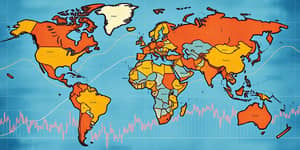As 2025 unfolds, the aftershocks of pandemic-induced supply shocks and geopolitical conflicts continue to reverberate across economies. The steep surge in prices since 2019 has left households, businesses, and policymakers grappling with uncertainty. In this article, we explore how inflation remains a global specter—its drivers, its varied faces in different regions, and the path forward.
The Unfolding of a Global Phenomenon
After peaking near 9% in 2022, global headline inflation has moderated but still hovers at levels unheard of in decades. According to the IMF and OECD, 2025 inflation is projected around 4.2%, roughly double pre-pandemic norms. While this slowdown offers relief, the pace of disinflation has slowed, and long-term expectations are inching upward.
Underlying these shifts are structural legacies of supply disruptions, expansive fiscal support, and tight labor markets. The cumulative price increase of 33.7% since December 2019 has erased years of purchasing power gains. For many, basic necessities like food, fuel, and rent remain a struggle, reinforcing the narrative of a cost of living crisis for households around the world.
Drivers of Spread and Persistence
Inflation today is shaped by intersecting pressures. While the pandemic shock is receding, new forces keep prices elevated. Understanding these drivers is key to crafting effective responses.
- Trade policy disruptions: Tariffs imposed by major economies act as supply shocks, pushing import costs higher.
- Commodity and energy volatility: Fluctuating oil and food prices continue to transmit directly to headline inflation.
- Monetary policy divergence: Central banks vary between cautious easing, aggressive tightening, and gradual normalization.
- High global debt burdens: Elevated public and private debt impedes swift policy adjustments.
These factors do not operate in isolation. For example, higher shipping costs from trade barriers amplify commodity price swings, while currency volatility in emerging markets worsens pass-through effects. The result is an uneven disinflationary landscape.
Regional Divergences in Detail
Inflation’s impact is far from uniform. Regional and national contexts produce stark differences in price pressures, policy responses, and outlooks. Below is a comparison of key forecasts from major institutions.
In advanced economies, the United States confronts sticky inflation above the Fed’s 2% target, compounded by lingering tariff effects. The Euro Area edges closer to target but still contends with energy and food price shocks. Japan, with its long battle against deflation, is slowly normalizing policy.
Emerging markets display even greater variance. Some, like Brazil and Nigeria, maintain high rates by further tightening. Others, such as India and South Korea, enjoy disinflationary winds and cautiously ease policy. Currency swings in countries like Turkey amplify headline rates, underscoring the fragility of progress.
Emerging Markets under Pressure
In 2022, inflation in emerging and developing economies approached double digits. While those rates have receded, local pressures remain high. Many nations face the dual challenge of controlling inflation without stifling growth or exacerbating debt-servicing costs. The combination of persistent geopolitical and policy uncertainty and uneven vaccine access in some regions has complicated recovery paths.
In Asia, disinflationary trends are most pronounced, benefiting export-driven economies. Latin America’s painful history of price volatility resurfaces in countries where fiscal deficits and political risks collide. Africa’s diverse economies struggle under high food price inflation and currency depreciation, straining household budgets.
Navigating Risks and Opportunities
As policymakers search for equilibrium, several wild cards could reshape the inflation outlook. These include unexpected energy price shocks, renewed trade tensions, and shifts in central bank credibility. The ability to adapt to evolving conditions will be a marker of success.
- Escalating geopolitical conflicts or tariffs
- Sudden spikes in oil or food prices
- Loss of central banks’ anti-inflation resolve
- Debt sustainability crises in heavily indebted nations
Amid these threats, opportunities emerge. Technological advances, digital trade facilitation, and strategic supply chain diversification can temper price pressures. Investments in renewable energy promise long-term stability against fossil fuel volatility. Regions that embrace innovation may find themselves on more stable footing.
Toward a Balanced Horizon
Looking ahead, the global economy stands at a crossroads. Will inflation settle into a new, higher norm, or can coordinated policy actions restore price stability? The answer will determine living standards for billions and shape the course of growth for years to come.
History teaches that inflationary bouts can leave lasting legacies. Central banks and governments must balance the twin imperatives of growth and price stability, mindful of the lessons from the post-2022 unwind. By aligning monetary caution with targeted fiscal support and embracing structural reforms, the world can navigate out of the shadow of inflation.
Ultimately, resilience will hinge on adaptability, cooperation, and foresight. In the face of lingering uncertainty, a shared commitment to pragmatic solutions can transform today’s challenges into tomorrow’s opportunities.
References
- https://www.ifo.de/en/facts/2025-04-09/economic-experts-survey-experts-expect-inflation-rates-rise-worldwide
- https://www.mckinsey.com/capabilities/strategy-and-corporate-finance/our-insights/global-economics-intelligence
- https://www.statista.com/statistics/1330092/global-inflation-rate-forecast/
- https://www.ey.com/en_us/insights/strategy/global-economic-outlook
- https://www.oecd.org/en/data/insights/statistical-releases/2025/07/consumer-prices-oecd-updated-3-july-2025.html
- https://www.mapfre.com/en/insights/economy/risks-global-economy-2025/
- https://www.worldbank.org/en/research/brief/inflation-database
- https://www.oecd.org/en/publications/2025/06/oecd-economic-outlook-volume-2025-issue-1_1fd979a8.html










